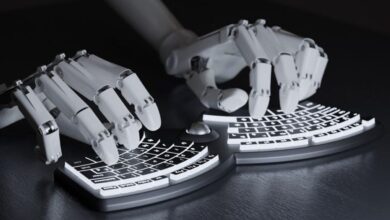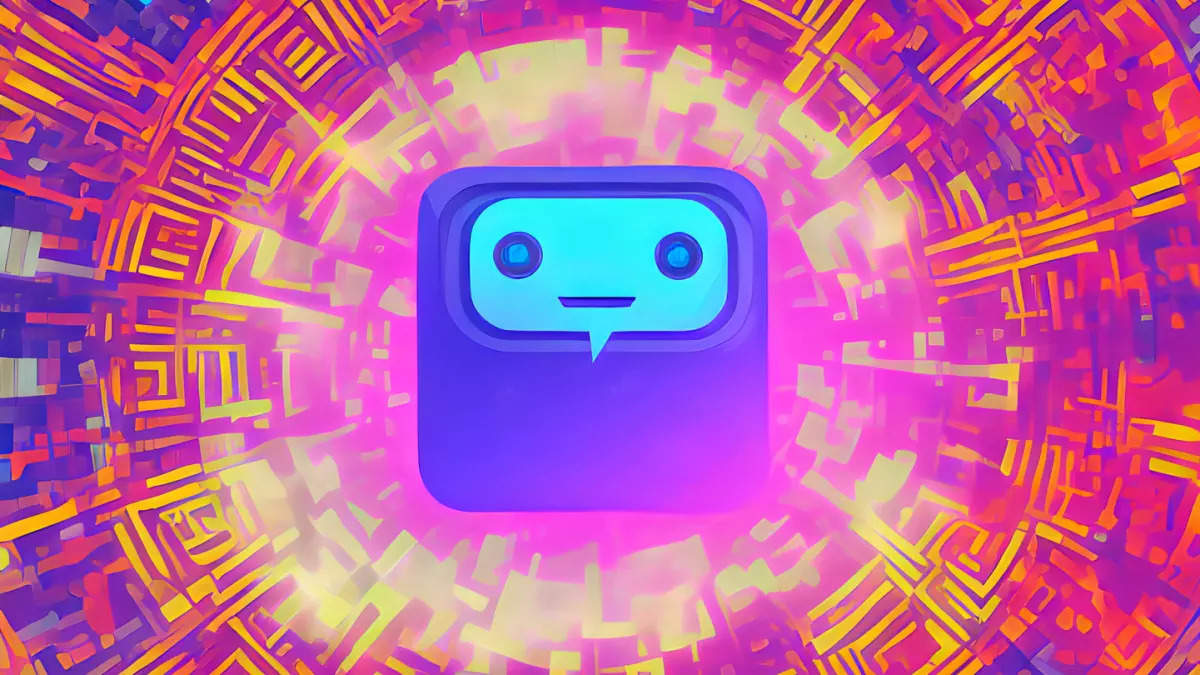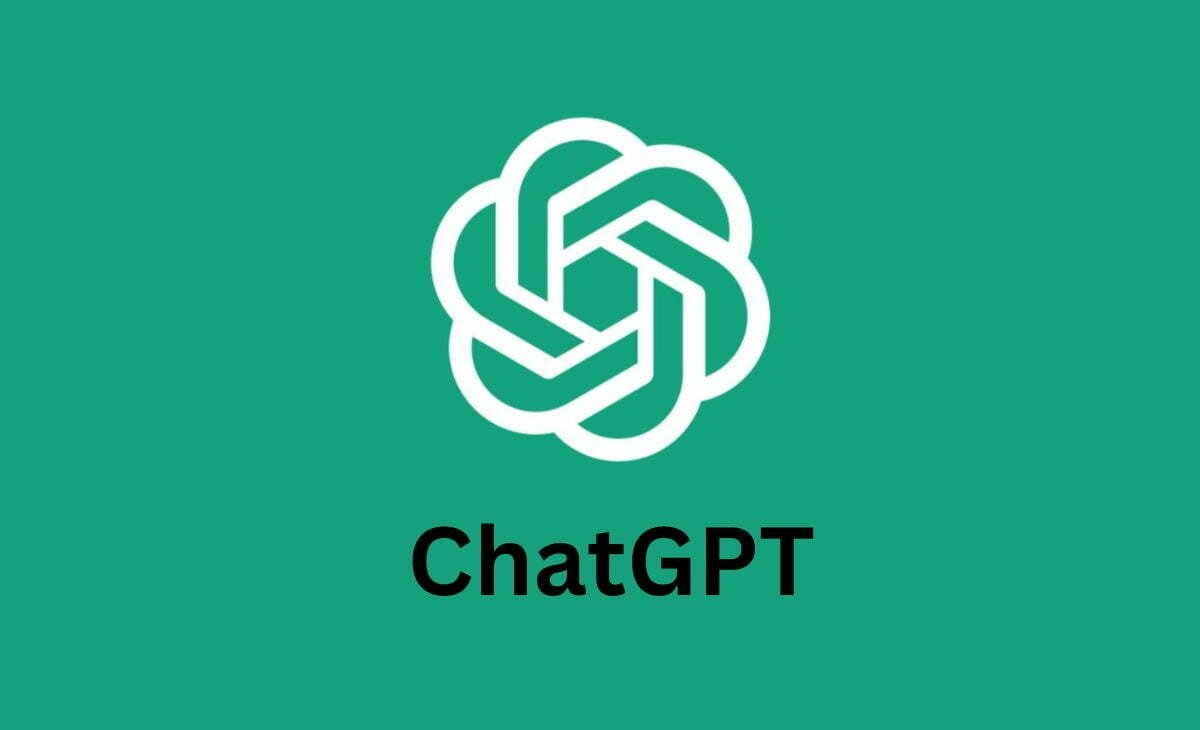Can you guess the ending? ✨ #ai #chatgpt #aiart
Can you guess the ending? ✨ #ai #chatgpt #aiart

In the dazzling realm of artificial intelligence, the question ‘Can you guess the ending?’ takes on new dimensions. From predicting outcomes in various fields to revolutionizing art and storytelling, AI’s capabilities are both intriguing and boundless. As we delve into the world where AI intersects with creativity and daily life, we explore how it not only augments human experiences but also challenges our perceptions of the future. This article ventures through the predictive power of AI, its influence on art, the evolution of conversational AI, the nostalgic fusion of AI with the 90s culture, and its integration into our everyday lives.
Key Takeaways
- AI’s predictive power is reshaping industries by forecasting outcomes with increasing accuracy, yet it faces inherent limitations.
- The art world is undergoing a transformation with AI-generated art, raising questions about authorship and the essence of creativity.
- ChatGPT’s ability to engage in dynamic conversations and craft stories with unexpected endings is redefining human-AI interaction.
- The 90s revival in tech, enhanced by AI, taps into nostalgia, offering unique engagement opportunities through retro aesthetics and experiences.
- AI’s role in personalizing daily life is expanding, from app recommendations to wellness, exemplifying its potential to tailor individual experiences.
Exploring the Predictive Power of AI
Understanding AI’s Ability to Forecast Outcomes
The allure of artificial intelligence lies in its capacity to analyze vast amounts of data and identify patterns that are imperceptible to the human eye. AI’s predictive power is harnessed across various sectors, from forecasting weather patterns to predicting stock market trends. By processing historical data, AI can make informed predictions about future events, but it’s important to recognize that these forecasts are probabilistic, not certain.
AI is not a crystal ball, and while its predictions can be incredibly accurate, they are ultimately based on the data it has been fed. This means that the quality of the data and the algorithms used are crucial in determining the accuracy of AI’s forecasts.
- The accuracy of AI predictions depends on the quality of data.
- Algorithms and models must be robust and well-designed.
- AI forecasts are probabilistic, not absolute guarantees.
The true power of AI in forecasting is not in its infallibility, but in its ability to provide us with a more informed starting point for decision-making.
Real-Life Examples of AI Predictions
The realm of artificial intelligence has seen remarkable achievements in forecasting outcomes across various domains. One of the most notable examples is the use of AI in weather prediction, where complex algorithms analyze vast amounts of data to forecast weather patterns with increasing accuracy. In the financial sector, AI-driven models are employed to predict stock market trends, helping investors make informed decisions.
Another area where AI shines is in healthcare, with algorithms that can predict patient outcomes and assist in early diagnosis. This predictive capability extends to sports analytics, where AI evaluates player performance to forecast game results. ChatGPT by OpenAI revolutionizes natural language processing, enabling interactive AI chat applications for various purposes like information retrieval, language assistance, idea generation, learning, task automation, entertainment, and more.
While AI’s predictive power is impressive, it’s important to remember that these systems are not infallible. They rely on the quality and quantity of data available, and their predictions are probabilistic rather than certain.
The Limitations of AI in Prediction
While artificial intelligence has made significant strides in forecasting outcomes, it’s crucial to recognize its limitations. AI systems are only as good as the data they are trained on, and they can struggle with unpredictability and novel scenarios. For instance, AI might excel in structured environments with clear rules, but it can falter in chaotic, real-world situations where human intuition plays a key role.
Uncertainty is a fundamental challenge for AI predictions. Despite advances in machine learning, AI cannot account for every variable, especially in complex systems where numerous factors interact in unpredictable ways. This leads to a degree of inaccuracy that must be acknowledged when relying on AI for forecasting.
- AI’s difficulty with rare or unseen events
- The challenge of ethical and unbiased decision-making
- The need for continuous data updates and model retraining
AI’s predictive capabilities are impressive, but they are not infallible. Understanding these limitations is essential for responsible use and setting realistic expectations.
The Intersection of AI and Art

How AI is Changing the Artistic Landscape
The advent of artificial intelligence has ushered in a new era of creativity, where the barriers to artistic expression are being dismantled. AI is democratizing the art world, enabling individuals without traditional artistic training to explore and innovate in ways previously unimaginable. This shift is not only altering how art is made but also how it is perceived and valued.
- AI-driven tools offer a plethora of options for novices and professionals alike, from generating complex patterns to simulating intricate brush strokes.
- The collaboration between human and machine is producing unique hybrid art forms, blurring the lines between artist and tool.
- Accessibility to AI technology is fostering a global movement of creators, expanding the diversity of artistic voices.
The landscape of innovation and artistic expression is evolving rapidly, with AI at the helm, empowering individuals to bring new ideas to life.
As we witness this transformation, it’s clear that AI’s role in art is not just as a facilitator but as a catalyst for a broader cultural shift. The future promises even more radical changes as AI continues to evolve and integrate into the creative process.
AI-Generated Art: Can We Guess the Artist?
The emergence of AI in the art world has sparked a fascinating challenge: Can you guess the ending? ✨ #ai #chatgpt #aiart. With algorithms now capable of creating visually stunning pieces, the line between human and machine-made art is blurring. Can we still discern the artist behind the artwork?
- AI-generated art often mimics the styles of famous painters.
- The complexity of textures and patterns can sometimes surpass human abilities.
- Audience reactions to AI art range from awe to skepticism.
The true test lies in an AI’s ability to not just replicate, but to innovate, pushing the boundaries of creativity.
While some may argue that AI lacks the emotional depth of human artists, others see it as a tool for limitless expression. The debate continues as AI art becomes more prevalent, challenging our perceptions of authorship and originality.
The Role of AI in Future Art Movements
As we look towards the future, the role of AI in art movements is poised to expand in unprecedented ways. AI’s integration into the creative process is not just about generating art; it’s about redefining the collaboration between human artists and technology. AI can serve as a tool for artists to explore new realms of aesthetics and conceptual ideas, pushing the boundaries of traditional art forms.
Artificial Intelligence is already influencing art by providing artists with new mediums and techniques. For instance, AI algorithms can analyze vast amounts of visual data to suggest unique color palettes or shapes that might not occur naturally to the human eye. This symbiotic relationship could lead to the emergence of new art movements that reflect the digital age we live in.
- AI as a co-creator, offering new perspectives
- Data-driven aesthetics shaping art trends
- Interactive installations with AI at the core
- The rise of AI-curated art exhibitions
The potential for AI to influence art is not just in creation but also in curation and interaction. As AI becomes more sophisticated, it could curate exhibitions that are tailored to individual preferences, making art more accessible and personalized than ever before.
ChatGPT: Conversations with a Twist

The Evolution of Chatbots to ChatGPT
The journey from simple chatbots to sophisticated platforms like ChatGPT marks a significant leap in artificial intelligence. Chatbots have transformed from basic text-based interfaces into complex systems capable of understanding and generating human-like text. This evolution has been driven by advancements in machine learning and natural language processing.
ChatGPT, in particular, represents a milestone in this progression. It’s not just a chatbot; it’s a conversational agent that can engage in nuanced discussions, answer questions, and even simulate certain aspects of human behavior. Here’s a brief look at how chatbots have evolved over time:
- Early chatbots were rule-based, responding to specific commands with pre-set answers.
- Machine learning introduced the ability to learn from interactions, improving responses over time.
- The introduction of deep learning and transformer models like GPT-3 has led to a new era of chatbots that can generate original, contextually relevant content.
The sophistication of these AI systems is not just a technical marvel; it’s reshaping how we interact with technology on a daily basis.
Surprising Conversations: When AI Goes Off-Script
The allure of AI lies in its ability to stick to the script, yet it’s the moments when it deviates that truly captivate us. ChatGPT is no exception, often delivering responses that leave users both amused and perplexed. These off-script moments can range from quirky misinterpretations to profound insights, showcasing the unpredictable nature of conversational AI.
Surprising conversations with AI are not just entertaining; they reflect the complex algorithms and learning processes that underpin these systems. Users on platforms like Quora are frequently sharing their experiences, asking others about the most unexpected response they have received from AI tools like ChatGPT.
- The most interesting answer
- Quirky misinterpretations
- Profound insights
The beauty of AI is that it can surprise us, sometimes saying “I don’t know” in a sea of seemingly infinite knowledge, reminding us of the technology’s evolving nature.
Teaching ChatGPT to Tell Stories with Unexpected Endings
The allure of a good story often lies in its ability to surprise us. ChatGPT has been trained to maintain this tradition by learning to craft narratives with twists that defy expectations. By analyzing patterns in countless tales, it can generate stories that start familiar but lead to unanticipated conclusions.
ChatGPT by OpenAI offers AI-driven conversational technology with advanced features, best practices, and feedback mechanisms. A user’s journey with ChatGPT might begin with a simple login guide, but as they explore alternative methods and the user dashboard, the experience becomes more enriched.
The challenge lies not just in creating a story, but in teaching an AI to understand the nuances of human surprise and satisfaction.
To foster this skill, several steps are taken:
- Introducing a diverse range of plot structures
- Encouraging creative deviations from standard story arcs
- Implementing feedback loops for continuous learning
The goal is to enhance the storytelling prowess of ChatGPT, making each conversation an opportunity to engage with something truly unique.
Nostalgia Meets Technology: AI in the 90s Revival

Retro Tech and AI: A Match Made in the 90s
The 1990s were a pivotal era for technology, marking a period where retro tech met the burgeoning field of artificial intelligence. This decade saw AI transition from a niche interest to a more mainstream fascination, as it began to weave its way into the fabric of everyday technology. The duality of AI during this time was characterized by significant advancements and a struggle for a defined identity within the tech world.
- Lemon8 invites us to ‘travel back to the 90s’ with vintage filters that evoke nostalgia.
- The expansion of AI in the 90s is not just about progress, but also about finding its place in the tech narrative.
Embracing the past to innovate for the future, AI in the 90s revival is not just a trend but a bridge connecting generations of technology enthusiasts.
As we look at the intersection of retro tech and AI, it’s clear that nostalgia is not just a powerful emotion but also a driving force for engagement and innovation in the AI space.
AI and the Resurgence of Vintage Filters
The digital world is experiencing a nostalgic revival, with AI playing a pivotal role in bringing vintage aesthetics back to life. AI-powered apps like Lemon8 are leading the charge, offering users a chance to sprinkle their digital life with a touch of the 90s. These apps provide a suite of retro filters that transform modern photos into classic masterpieces, reminiscent of the days when film cameras were the norm.
- Lemon8’s ‘Best vintage Filters You Should Try’ feature
- Easy sharing options to social platforms like Facebook, WhatsApp, and Twitter
- Enhanced app experience with additional posts, hashtags, and features
Embracing the past while looking forward to the future, AI is not just reviving old visual styles but also enhancing them, making it easier than ever to create images that feel both timeless and contemporary.
Moreover, the integration of AI in photo restoration tools like Phot.AI is revolutionizing the way we preserve history. Users can now effortlessly recover and repair old images, restoring them to their original quality with just a few clicks. This seamless blend of past and present is a testament to AI’s transformative impact on our visual culture.
Why Nostalgia is a Powerful Tool for AI Engagement
In the digital age, nostalgia serves as a bridge between the familiar past and the innovative present. Nostalgia marketing taps into the collective memory, evoking emotions that foster a deeper connection with users. AI, with its ability to analyze and replicate patterns, is perfectly positioned to leverage this trend.
AI engagement is heightened when users encounter elements that remind them of a simpler time. This is evident in apps that feature vintage filters or retro-themed interfaces. For instance, Lemon8 invites users to “travel back to the 90s” with features that resonate with a sense of nostalgia.
- Lemon8’s vintage filters
- Retro-themed app interfaces
- Nostalgic posts and hashtags
By integrating nostalgia into AI, brands create a unique experience that stands out in a crowded digital landscape. It’s not just about looking back; it’s about using the past to enhance the present.
The Rise of Nostalgia Marketing in a Digital World highlights how nostalgia helps brands create a sense of familiarity and authenticity, crucial for engagement in the social media era.
Enhancing Daily Life with AI

AI in Everyday Apps: Enhancing User Experience
The integration of Artificial Intelligence (AI) into everyday applications has revolutionized the way we interact with technology. AI algorithms are now adept at learning from user behavior, tailoring experiences to individual preferences and needs. This personalization extends across various domains, from social media to productivity tools.
- Social Media: AI curates feeds based on what you like, share, and engage with.
- Productivity: AI suggests tasks and schedules based on your work habits.
- Lifestyle: AI offers personalized health and wellness advice.
The seamless fusion of AI with user interfaces has made apps more intuitive and responsive, significantly enhancing the overall user experience.
As AI continues to evolve, it promises to deliver even more sophisticated and nuanced interactions, making our daily digital engagements more enjoyable and efficient.
Personalized AI Recommendations: From Fashion to Food
In the realm of personalization, AI has become a stylist and a chef, curating experiences tailored to individual tastes. Boldly navigating through the vast sea of options, AI algorithms analyze user preferences to suggest fashion items that resonate with personal style or meals that cater to dietary restrictions and flavor inclinations.
- Fashion recommendations may include clothing, accessories, and even entire outfits based on past purchases and browsing history.
- Food suggestions can range from recipes to try at home to restaurant dishes, considering factors like health goals and taste profiles.
The beauty of AI-driven recommendations lies in their ability to learn and adapt over time, ensuring that each suggestion feels more personalized than the last.
While the convenience of AI in fashion and food is undeniable, it’s essential to remember that these systems are only as good as the data they’re fed. A diverse and accurate dataset is crucial for AI to truly understand and cater to the nuances of individual preferences.
AI’s Role in Wellness and Fitness: A New Frontier
The integration of artificial intelligence (AI) into wellness and fitness represents a groundbreaking shift in how we approach personal health. AI’s capacity to personalize fitness plans and wellness advice is revolutionizing the industry. By analyzing individual health data, AI can suggest tailored workout routines, dietary recommendations, and even stress management techniques.
- AI-powered apps track progress and adjust plans in real time.
- Virtual coaches provide motivation and correct form during exercises.
- Wearable devices use AI to monitor vital signs and predict health trends.
The synergy between AI and wellness is not just about smarter fitness trackers or more interactive apps; it’s about creating a holistic approach to health that is both proactive and deeply personalized.
As we continue to explore the potential of AI in this domain, we are likely to see even more innovative applications that make wellness and fitness more accessible, enjoyable, and effective for everyone.
Artificial Intelligence (AI) is revolutionizing the way we live, work, and play, enhancing our daily lives with smart solutions that simplify tasks, improve efficiency, and unlock new possibilities. From optimizing your home’s energy usage to providing personalized health recommendations, AI is the silent partner in your quest for a smarter, more connected life. Don’t miss out on the latest AI advancements that can make a significant impact on your daily routine. Visit our website to explore how AI can transform your life today and prepare you for the future. Embrace the change and enhance your life with AI.
Conclusion
As we’ve explored the fascinating world of AI and its applications in chatbots and AI-generated art, it’s clear that the possibilities are as vast as our imaginations. Whether you’re reminiscing about the 90s with vintage filters or sharing your AI-driven creations on social platforms like Lemon8, the journey through AI’s capabilities is an exciting one. With every new development, we edge closer to a future where AI is not just a tool, but a collaborative partner in our creative endeavors. So, can you guess the ending? Perhaps the true beauty of AI is that it’s constantly evolving, and the story is far from over. Keep experimenting, sharing, and enjoying the full app experience as we continue to witness the growth of AI in our daily lives.
Frequently Asked Questions
How does AI predict outcomes in various fields?
AI predicts outcomes by analyzing large datasets to identify patterns, trends, and correlations. It uses algorithms and machine learning models to forecast future events based on historical data.
Can AI-generated art be distinguished from human-created art?
It’s becoming increasingly difficult to distinguish AI-generated art from human-created art. AI can mimic styles and techniques, making the origin of the artwork a challenge to guess.
What makes ChatGPT different from traditional chatbots?
ChatGPT is powered by advanced natural language processing, allowing it to understand context and maintain more coherent and complex conversations compared to traditional rule-based chatbots.
How is AI contributing to the 90s revival in technology and culture?
AI is enabling the creation of retro-inspired digital content, including vintage filters and nostalgic app experiences, by learning from past trends and applying them to modern technology.
In what ways does AI enhance our daily app experiences?
AI enhances daily app experiences by providing personalized recommendations, optimizing user interfaces, and automating tasks to improve efficiency and user satisfaction.
What is Lemon8, and how does it relate to AI and nostalgia?
Lemon8 is an app that incorporates AI to offer personalized experiences with a nostalgic touch, featuring vintage filters, daily notes, and a community focused on categories like fashion, wellness, and travel.



